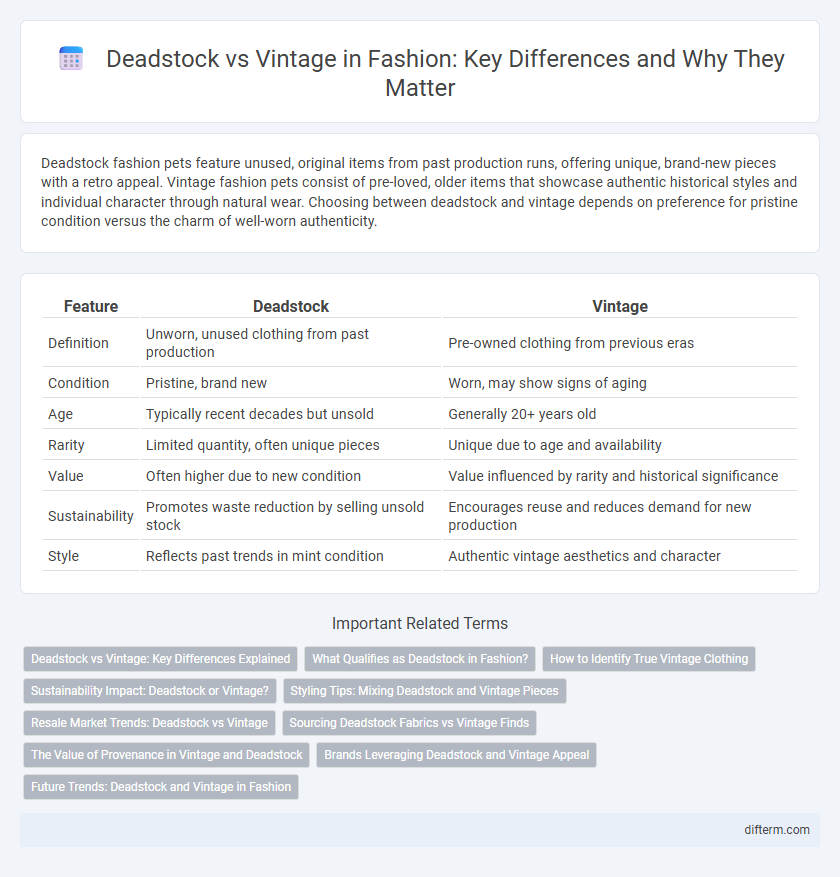Deadstock fashion pets feature unused, original items from past production runs, offering unique, brand-new pieces with a retro appeal. Vintage fashion pets consist of pre-loved, older items that showcase authentic historical styles and individual character through natural wear. Choosing between deadstock and vintage depends on preference for pristine condition versus the charm of well-worn authenticity.
Table of Comparison
| Feature | Deadstock | Vintage |
|---|---|---|
| Definition | Unworn, unused clothing from past production | Pre-owned clothing from previous eras |
| Condition | Pristine, brand new | Worn, may show signs of aging |
| Age | Typically recent decades but unsold | Generally 20+ years old |
| Rarity | Limited quantity, often unique pieces | Unique due to age and availability |
| Value | Often higher due to new condition | Value influenced by rarity and historical significance |
| Sustainability | Promotes waste reduction by selling unsold stock | Encourages reuse and reduces demand for new production |
| Style | Reflects past trends in mint condition | Authentic vintage aesthetics and character |
Deadstock vs Vintage: Key Differences Explained
Deadstock refers to brand-new, unworn clothing items that were never sold or used, often sourced from old inventory or past production runs. Vintage apparel, on the other hand, consists of genuinely used garments typically over 20 years old, carrying historical and cultural value with signs of wear and age. The key differences lie in condition, rarity, and authenticity, with deadstock prized for pristine quality and vintage valued for its unique character and nostalgic appeal.
What Qualifies as Deadstock in Fashion?
Deadstock in fashion refers to unworn, unused clothing or accessories that were never sold to consumers and remain in their original condition, often still with tags attached. These items typically come from past seasons and are preserved in inventory, making them highly sought after by collectors and sustainable fashion enthusiasts. Unlike vintage, which denotes clothing typically over 20 years old and previously worn, deadstock guarantees brand-new condition despite its age.
How to Identify True Vintage Clothing
True vintage clothing can be identified by examining garment construction techniques such as hand-sewn seams, original manufacturer labels, and fabric types specific to past decades. Look for signs of aging like natural fading, slight wear on hems, and period-accurate buttons or zippers that match the era. Authentic vintage pieces often have provenance or tags indicating production dates, distinguishing them from deadstock, which is unworn but not aged clothing from previous production runs.
Sustainability Impact: Deadstock or Vintage?
Deadstock fashion reduces waste by utilizing unsold, never-worn garments that would otherwise contribute to landfill accumulation, offering a sustainable alternative by extending the lifecycle of existing inventory. Vintage clothing emphasizes circularity by repurposing decades-old garments, minimizing resource consumption associated with new production and preserving textile longevity. Both approaches significantly lower environmental impact compared to fast fashion, with vintage promoting cultural preservation and deadstock preventing unnecessary manufacturing.
Styling Tips: Mixing Deadstock and Vintage Pieces
Styling deadstock and vintage pieces together creates a unique fashion statement by blending untouched, original items with nostalgic, character-rich garments. Pair crisp, unused deadstock basics like a pristine white tee or denim jeans with vibrant vintage accessories or statement outerwear to balance freshness and history. Emphasize contrasts in texture and color to highlight the individuality of each piece while maintaining a cohesive look that respects both eras.
Resale Market Trends: Deadstock vs Vintage
Deadstock items in the resale market attract collectors seeking unworn, original-condition fashion pieces, often commanding higher prices due to rarity and pristine quality. Vintage clothing appeals to buyers valuing unique, well-preserved styles with historical significance, driving demand for authentic labels and era-specific trends. Market data shows increasing interest in deadstock as sustainable consumption grows, while vintage maintains steady value by offering timeless appeal and nostalgic exclusivity.
Sourcing Deadstock Fabrics vs Vintage Finds
Sourcing deadstock fabrics involves acquiring unused, surplus materials from past production runs, offering designers access to limited-edition textiles with minimal environmental impact. Vintage finds consist of pre-owned garments or fabrics, valued for their uniqueness and historical significance, often requiring careful restoration. Both approaches support sustainable fashion by reducing waste and extending the lifecycle of textiles unseen in mainstream collections.
The Value of Provenance in Vintage and Deadstock
The value of provenance in vintage and deadstock fashion significantly enhances authenticity and desirability, linking garments to specific historical periods and designers. Provenance provides transparency about origin, rarity, and condition, which justifies higher market prices and collector interest. This traceability assures buyers of genuine craftsmanship and adds cultural and sustainable value to the pieces.
Brands Leveraging Deadstock and Vintage Appeal
Brands leveraging deadstock fabrics capitalize on exclusive, unused materials from previous seasons to create limited-edition collections that emphasize sustainability and uniqueness. Vintage-inspired brands source authentic garments or replicate classic styles, appealing to consumers' desire for nostalgia and timeless fashion with a reduced environmental footprint. Both strategies highlight the growing demand for eco-conscious fashion by blending heritage craftsmanship with modern ethical values.
Future Trends: Deadstock and Vintage in Fashion
Deadstock and vintage fashion are poised to shape sustainable trends by offering unique, high-quality pieces that reduce waste and promote circularity in the industry. The rising consumer demand for authenticity and eco-conscious choices accelerates the integration of deadstock and vintage items into mainstream fashion markets. Innovators in retail technology are enhancing accessibility and discovery, enabling broader adoption of these styles and affirming their role in the future of ethical fashion.
deadstock vs vintage Infographic

 difterm.com
difterm.com